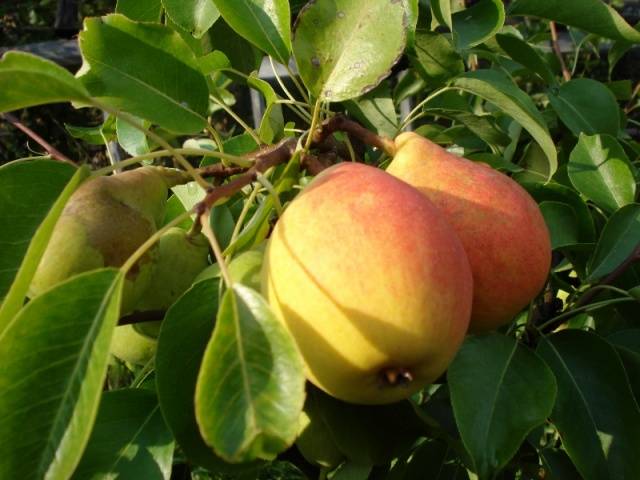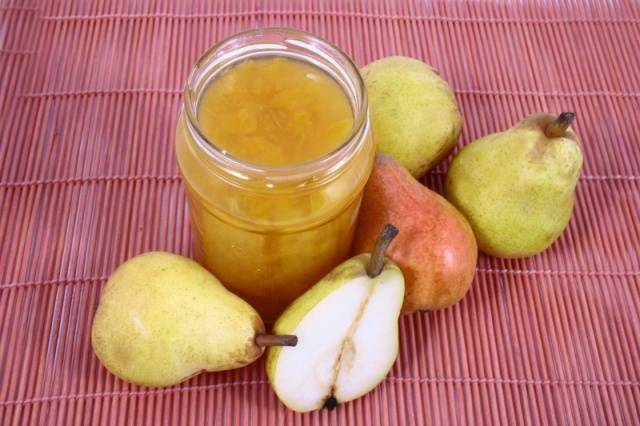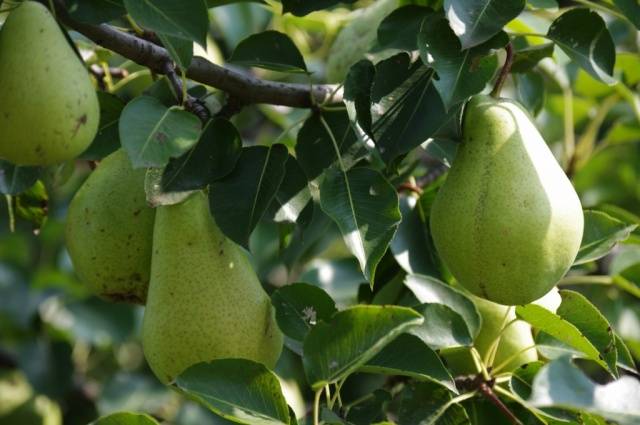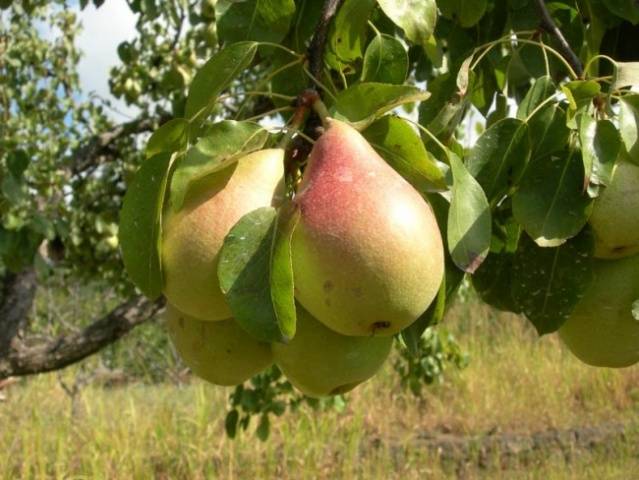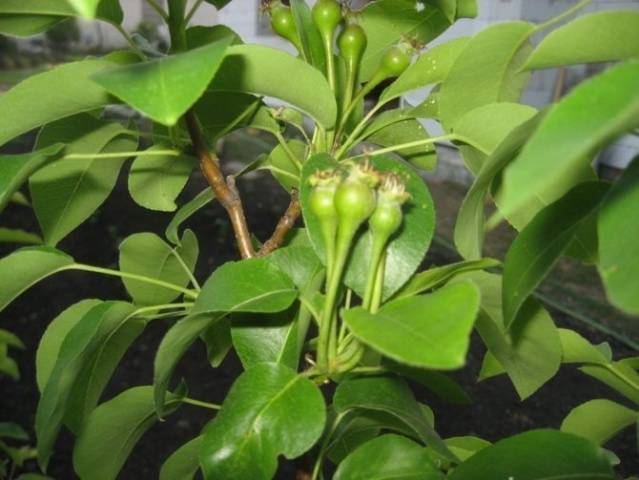Content
The magnificent Forest Beauty has been deservedly popular for about two centuries. The pear is remarkable for its remarkable fruits, high yield, winter hardiness and durability. In the southern regions of our country, this early autumn dessert variety is grown almost everywhere. Pear Forest Beauty comes from Belgium. It has spread very widely. In spring, its powerful wide-pyramidal crown pleases with exuberant flowering, and in summer it presents with perfect-looking, sweet and juicy pears.
Description of the variety
Tree structure
The fast growing tree of this pears with a spreading, rather rarely leafy crown, - medium height, up to 5 meters in height. Rough gray bark. The branches are slightly drooping. Straight, strong shoots are covered with a dark bark with a reddish tint, may be slightly curved. Medium-sized lentils are visible on them.
Medium or even small, ovoid, pointed leaves - elongated, smooth, not pubescent. The edges of the leaves are finely serrated. Petioles are thin and long. Small leaf buds are sharp, with a silvery sheen.
The flowers are also small, white, with pinkish tints, with a half-open calyx. Inflorescences are diverse: single and group, 6-10 flowers each. The peduncle is strong, short, distinguished by thickenings at both ends, and may be slightly curved.
Physical characteristics of fruits
Medium-sized convex fruits of the Forest Beauty pear have a characteristic truncated-ovoid shape. The funnel of the fruit is small and narrow. The usual weight of these attractive fruits is from 120 to 150 g. In the south, in areas with rich soils, there are record fruits - 250 and even 300 g.
Fragrant pears have a rough, dense, but thin skin. Unripe fruits are greenish-yellow. In the full phase of ripeness, the fruits are golden yellow, from the side of the sun - with a bright blush, which sometimes captures the entire barrel of the pear, from top to bottom. The skin is distinguished by many grayish subcutaneous dots, small brown spots.
In the middle part of the fruit there is a seed chamber with light or dark brown grains, large, with a sharp tip.
Quality indicators of fruits
The pulp of the Forest Beauty pear is light yellow, juicy, with a rich aroma.
- Differs in a delicate, slightly oily, melting consistency;
- The pear fruit tastes very good: sweet, with a barely noticeable, appropriate sourness;
- In 100 g of pears of this variety - 47 calories, 8-10 g of sugar, 13.8 g of dry matter;
- Fruits contain many B vitamins, valuable macro- and microelements necessary for health. Potassium content - 155 mg, calcium - 19 mg, phosphorus - 16 mg, magnesium - 12 mg, fluorine - 10 mg. There is also iron, zinc, iodine, and selenium.
Features of the variety
This pear is a real gift from nature if it was really just discovered in the Flemish forest. Although there is information that the tree was nevertheless bred in the 18th century in the same area. This pear has amazing qualities.
- A wonderful property of the wood and flowers of the Forest Beauty pear is its amazing insensitivity and resistance to morning frosts in April or May.This pear variety also holds the lead in tolerance to winter 50-degree frosts;
- For the first eight years, the pear tree of this variety grows most intensively;
- Fruit ripening occurs in August, the timing depends on climatic conditions;
- Fruits are preferable to be consumed fresh, although they can also be used for compotes (with the addition of other fruits for a more pronounced taste).
How to get more yields
- The fruits are obtained 7-8 years after planting, if the stock is a forest pear tree. A seedling grafted on a quince begins to bear fruit 3 years earlier;
- Particularly productive are those branches that are 4 years old;
- This pear is partially self-fertile: 75-80% of the ovaries occur during self-pollination. It is better to prudently plant a tree such as Limonka, Williams, Aleksandrovka, Bessemyanka, Bon-Louise Avranches nearby, Clapp's Favorite, Vera Hardy, Josephine Mechelnaya;
- Fruiting of a tree of this variety is annual, but there is a periodicity of yield after a year. In quantitative terms, this is expressed as follows: 50-100 kg of fruits from one young (up to 20 years old) tree; A 25-30 year old tree gives 50-80 kg more; a tree from 40 years old reaches a 200-kilogram harvest. In Crimea, up to 400 kg are obtained from individual trees.
Advantages and disadvantages
The recognized advantages of the Forest Beauty pear variety abound, which is confirmed by the constant love of gardeners for it:
- Exceptionally tasty fruits;
- Apparent frost resistance and drought resistance;
- The tree is undemanding to care and soil;
- Excellent yield.
The queen of gardens, the Forest Beauty pear also has a negative characteristic.
- The tree is prone to early overripening of fruits, which then crumble;
- Susceptible to scab;
- Ripe fruits are not stored for long.
Growing a tree
A tree of the Lesnaya Krasavitsa pear variety will be comfortable in an area of free air flow and good sunlight. The pear is planted in spring or autumn.
Landing subtleties
Better to take a two-year-old pear tree Forest Beauty. A pit for a seedling is prepared in a week.
- Dig a hole 80–100 cm deep, 80–90 cm wide;
- The dug soil is mixed with humus and sand - 20 kg each, 100 g of potassium sulfate and 200 g of superphosphate are added;
- The mixture is poured into a pit and poured with a solution that has been infused for a week: 600 g of dolomite flour per 30 liters of water;
- A tree is placed next to a peg installed in the center of the pit, straightening the roots;
- When sprinkling the seedling with soil, place the root collar 5–6 cm above the ground;
- The tree is tied to a peg and two buckets of water are poured around the center of the hole;
- The near-stem circle is mulched with dry earth or fine sawdust.
Watering and feeding
For watering at a time, the seedling needs at least 10 liters of water. In summer, seedlings are watered once a week, 30-40 liters. Adult trees are given abundant watering four times a year:
- Before flowering;
- When dumping excess ovaries;
- During the dry season when ripe;
- In October, 80-90 liters of water are charged under adult trees.
Forest Beauty two-year-old pear trees are fed depending on the soil:
- Annually - on the sandy;
- After 2-3 years on black earth or clay;
- In the spring, humus is introduced - two kilograms per square meter;
- In the fall, fertilize for 1 sq. m mineral composition: wood ash - 650 g, carbamide - 15 g, ammonium nitrate - 20 g, superphosphate - 50 g.
Crown formation
Some gardeners claim that the Forest Beauty pear tree is painfully tolerant of pruning.But it is necessary to regulate the growth of the tree, and the yield after pruning will increase steadily.
- In the second year, in the spring, the main shoots are shortened by a third;
- In the fall, diseased or damaged branches are cut;
- A fruitful tree is rejuvenated after three years: dry branches that thicken the crown are removed.
The cuts must be treated with garden pitch.
Whitewashing - preparation in winter
The pear seedling is not wrapped up for the winter, but they take care of the trunk from mice or hares. The tree can be wrapped in old nylon clothes or whitewashed in October, at a temperature of +50 With a special composition. The solution for whitewashing is insisted for three hours: water - 8 liters, copper sulfate - 200 g, lime and mullein - 1 kg each.
Diseases and pests of pear
- Scab, powdery mildew and rust affect fruits and trees of the Forest Beauty pear variety. For prophylaxis in spring, trees are sprayed with copper chloride - 0.5% solution: when the buds open and after flowering;
- Recently, a new disease has been spreading - a fire blight, when the leaves turn brown and dry in the spring. With its signs during the flowering period, trees are sprayed five times with Bordeaux liquid or streptomycin solution;
- For scab in the fall, 1% Bordeaux liquid is used;
- The preparations "Hom" and "Oxyhom" help the tree to fight against fruit rot and cytosporosis.
The pear of this variety does not give up its positions. More than 30 new varieties of pears were bred on its material.
